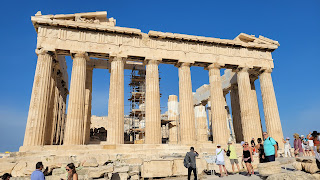The
All-American Musical Instrument
By
Jeffrey M. Bowen
If you were asked to name the quintessential American musical
instrument, think banjo. Think of hillbillies enlivening a bluegrass festival
or a country folk revival, or the sad background strumming of a PBS video Civil
War documentary. My personal memories
include Appalachian backwoods dueling banjos in the classic movie
“Deliverance,” and the musical mischief of the Spike Jones band back in the
1950s. Ask Alexa to play banjo music and
fast-tempo country sounds will be launched.
Historical roots are found in West Africa, and to a later extent
in European traditions. The earliest models arrived on 18th century
slave ships often landing in the Caribbean.
Music historians describe primitive types as gourds covered with animal
skins and necks made of sticks without any frets. Modern banjos have four or five steel
strings. The older types have a fifth short string called a drone or thumb
string which is used to play rhythmic upbeats to accompany the main
melody.
Recently I took a close look at a banjo inherited by my
brother-in-law Jim Horky. It is built on a circular frame consisting of a
resonator and neck. The essential
element is a hollow rim covered with a membrane. The resonator amplifies the sound. Many
diverse types of wood are used in construction, ranging from maple and walnut
to mahogany. Different woods yield brighter or richer sounds.
What intrigues me about the one my brother-in-law inherited is
that the entire rim is lined with heavy and sturdy metal. This was added to
protect the life of the instrument. Apparently it needed to be rugged. Along with a
mandolin and guitar, the instruments were bequeathed to my brother-in-law by
his uncle Gerhard Martis, a multi-talented musician from Nebraska.
Gerhard (1897-1956) was a worldwide musical traveler who played
in big and small bands in the 1930s and 40s.
I was told that Phil Harris, a very popular
band leader of the era, rewarded Gerhard with a nice plot of land near
Hollywood Boulevard, but it went into arrears because he could not be bothered
to pay taxes on it.
Gerhard was a handsome fellow who could play about any stringed
instrument in an orchestra. A photo suggests that one of his gigs involved the
SS Niagara as it cruised from Sidney, Australia to New Jersey. My
brother-in-law inherited Gerhard’s banjo partly because he, too, is musically
talented. It pleases both of us to think that what Gerhard Martis left behind
is American musical history to our ears.

